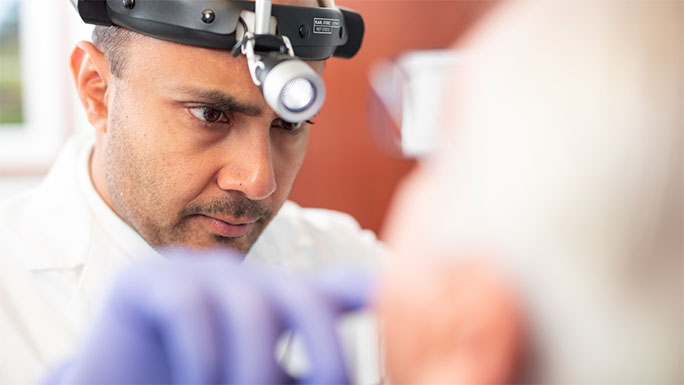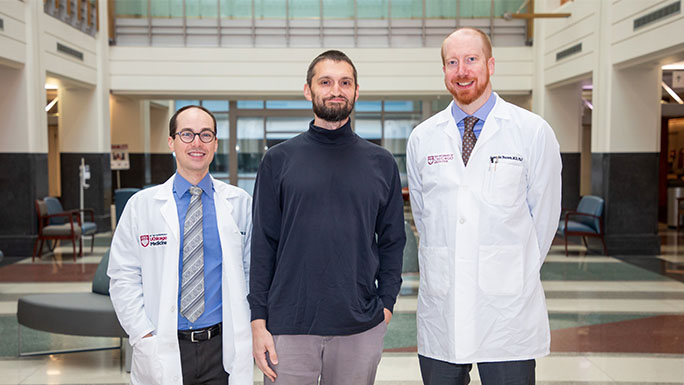First he survived cancer – now he studies it

Dmitry Karpeyev, PhD, first realized something was wrong when he developed a chronic stuffy nose. When he finally saw his doctor, he received devastating news. His congestion was caused by a large tumor at the base of his skull.
It would take a team of seven physicians to remove the tumor, treat his cancer and ultimately, save the computational scientist's life. Since then, Karpeyev has shown his gratitude by volunteering his time to research the type of cancer he had.
Karpeyev was diagnosed with adenoid cystic carcinoma (ACC) in August 2020. ACC is a rare type of cancer that develops in secretory glands in the head and neck, most often in the salivary glands.
Karpeyev was diagnosed elsewhere and met with doctors at several hospitals in the Chicago area before he came to the University of Chicago Medicine. He felt comfortable with his team right away.
“It was immediately clear that they knew what they were doing. And they were so caring,” he said.
At his first appointment, Karpeyev met Nishant Agrawal, MD, Co-Director of Head and Neck Surgical Oncology, who would eventually lead Karpeyev's cancer team.
Agrawal explained that not only did Karpeyev have ACC, the cancer was advanced and aggressive. It would require extensive surgery to remove the tumor and reconstruct the upper parts of his face.
To help explain the treatment, Agrawal invited other physicians to that first meeting to draw upon their expertise. The specialists included Lawrence Gottlieb, MD, Director of the Burn and Complex Wound Center, and Russell Reid, MD, PhD, who focuses on reconstructive surgery of the face, jaw, palate and skull.
Together, they went through how they would remove Karpeyev’s tumor through surgery and reconstruct his face. They drew diagrams to illustrate the process.
This visual explanation appealed to Karpeyev’s engineering sensibilities. “It kind of jives with me when someone draws a picture and shows me exactly what’s going to happen,” he said.
Karpeyev knew he had found the team he wanted to treat his cancer.
Assembling a multidisciplinary team
Agrawal specializes in ACC and has researched it extensively. But he knew he needed assistance with Karpeyev's case.
“As soon as we saw his scans, we knew that this was pretty advanced and aggressive. It was going to require a lot of expertise in the room,” Agrawal said.
“Nothing about this case was typical. He had a pretty rare tumor in an uncommon and difficult location involving his maxilla and palate. And even rarer was how advanced it was locally, the extent of it and the involvement of some of the nerves.”

The tumor was located above the roof of the patient's mouth and behind his nose and eyes. The surgical team strategized to minimize invasive techniques and ensured they were on the same page as Karpeyev every step of the way.
Karpeyev remembers one reassuring appointment with Agrawal and Peleg Horowitz, MD, PhD, a neurosurgeon with expertise in skull base tumors like this one.
“I asked Dr. Agrawal, ‘Why do we need a neurosurgeon?’ He could sense that I would freak out,” Karpeyev said. “He said, "Don’t worry. He needs to do it because the base of the skull is involved and it’s close to the brain.’”
Ordinarily, to remove this sort of tumor, the surgical team would have to open up the skull, a complex and dangerous procedure. But Karpeyev remembers Horowitz saying, “We think we have a slick way to go around this thing.” Horowitz explained how he and his team would use an endoscope – a tube connected to a camera and light – to separate the tumor from the base of the skull. The endoscope would go through the nose, and push between the top of the tumor and normal tissue.
The surgery lasted over 18 hours. Agrawal and Horowitz, as well as Jayant Pinto, MD, a surgeon specializing in sinus and nasal diseases, worked together to remove the cancerous tissue from Karpeyev’s head and neck.
“We removed the roof of his mouth, some of his cheekbones, some of the nasal structures, some of the sinuses, and then we removed the lymph nodes in both sides of his neck,” Agrawal said.
Once the cancerous tissue was removed, Gottleib and Reid reconstructed Karpeyev’s face and mouth using bone and skin from his leg. Karpeyev recalled Gottleib explaining how they could use his bone without harming other parts of his body, using humor to provide reassurance.
It’s been almost two years now, and they still make all the time for me. Every time I see them, I am reminded how much they care.“Dr. Gottlieb said: ‘Guess what? You don’t need the fibula. It’s not load-bearing. God made you with two bones – one so you could walk and the other for plastic surgeons.’ He was cracking these jokes,” Karpeyev said. “It was a bit scary but somehow comforting. It seemed like he had it under control.”
Even with the large amounts of bone and tissue that had to be removed, the reconstruction was a success. “They basically took my whole mouth and most of my sinuses. It was kind of a lot. My face has changed, and I have no upper teeth. But I have a denture and can eat most everything. And I still look like a human being, which is only thanks to them,” Karpeyev said.
But even after extensive surgery, Karpeyev was not yet cancer-free.
“After he recovered from the surgery, we started planning for almost two months of radiation therapy and chemotherapy,” Agrawal said.
Karpeyev was treated by oncologists Daniel Haraf, MD, and Alexander Pearson, MD, PhD, to destroy any remaining cancerous tissue lower the risk of a recurrence.
Pearson also researches how to better diagnose and treat head and neck cancers via mathematical models. When Karpeyev learned this, he saw an opportunity to fight cancer in another way.
Lending his own expertise
Karpeyev has a PhD in computer science and applied math and once worked as a scientist at Argonne National Laboratory. He later transitioned into finance and used his training to predict market behavior before segueing to a self-driving car startup.
But during his treatment, he realized he could apply his wealth of experience to cancer research. “I thought, ‘I want to be part of this. I want to do something. I want to help somehow,’” he said.
Karpeyev started working with Pearson’s group. “They look at high-resolution photographs of histology slides – basically samples of cancer tissue,” Karpeyev said. “The photographs are taken by their high-resolution microscope and then analyzed using machine learning models to recognize different kinds of cancer.”

Karpeyev delved into image-processing methods to better identify and diagnose cancer from images of tissue. “Pearson’s group said, ‘This sounds great. Let’s try some of these methods.’ And the results showed that these methods actually do improve cancer diagnosis, and so we submitted a paper,” Karpeyev said. UChicago Medicine is designated as a Comprehensive Cancer Center by the National Cancer Institute, the most prestigious recognition possible for a cancer institution. We have more than 200 physicians and scientists dedicated to defeating cancer. Nishant Agrawal, MD, specializes in treating benign and malignant tumors of the head and neck. He serves as section chief of otolaryngology - head and neck surgery as well as director of head and neck surgical oncology. 
UChicago Medicine Comprehensive Cancer Center

Nishant Agrawal, MD
